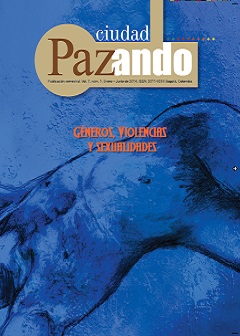DOI:
https://doi.org/10.14483/udistrital.jour.cpaz.2014.1.a09Published:
2014-09-17Issue:
Vol. 7 No. 1 (2014): Violence, genders and sexualitiesSection:
Notas al margenMEDIA ETHICS IN WARTIME: THE CODE FOR THE COVERAGE OF THE COLOMBIAN ARMED CONFLICT
Downloads
Abstract (es)
By analysing the “code for the coverage of the Colombian armed conflict”, this paper argues that journalism ethics needs to be understood not only as a matter of journalists. Ethics also depends on the context which journalists do their job. For example, in wartime, the reporting of news is influenced not only by the economic, symbolic and media constraints, but also by the strategic aims of the armed groups. Thus, ethics codes are more than documents in which journalists state how to do their job in a right way. Like the case of the Colombian armed conflict illustrates, ethics codes are documents in which journalists defend their independence, protect themselves from threats and argue for better work conditions. In this sense, ethics codes in wartime function more as political acts of communications rather than just training documents.
References
Arias, Edgar, Chacón, Luis, Cristancho, Francisco, & Quebedo, Norbey (2003): Tratamiento de los actos violentos en los noticieros de la televisión colombiana, Universidad Sergio Arboleda, Bogotá.
Berkowitz, Daniel (2009): "Reporters and Their Sources", in K. Wahl-Jorgensen & T. Hanitzsch, Editors: The Handbook of Journalism Studies, Taylor & Francis New York, (pp. 102–115).
Bonilla, Jorge Iván (2002): "Periodismo, Guerra y Paz. Campo intelectual periodístico y agendas de la información en Colombia", Signo y Pensamiento, XXI(40), (53–70).
Carlson, Matt (2009): "Dueling, Dancing, or Dominating? Journalists and Their Sources", Sociology Compass, 3(4), (526–542).
Castro, Germán, Villamizar, Dario, Restrepo, Andrés, & Guerrero, Arturo (2005): Diccionario para desarmar la palabra (2. ed.). Corporación Medios para la Paz, Planeta, Bogotá.
CNTV (1997). Servicio Público y Cobertura, Sistema de Televisión en Colombia. Comisión Nacional de Televisión, Bogotá.
CPB (1990): Código de ética y responsabilidad del periodista. Círculo de Periodistas de Bogotá, Bogotá, http://www.medios paralapaz.org, consulted 13/02/2010.
El Colombiano (2003): Manual de estilo y redacción, Impolibros S.A., Colombia.
El Tiempo (2003): Conflicto armado y terrorismo. Manual de cubrimiento: El conflicto armado en las páginas de El Tiempo, Casa Editorial El Tiempo Bogotá.
Flores, Pamela, & Crawford, Linvingston (2001): "El papel de los relatos noticiosos en la construcción de un proyecto comunicativo para la paz en Colombia", Diálogos de la Comunicación, 61, (46–55).
García, María Eugenia, & Romero, Edward (2001): "Las trampas de la aparición. Información y conflicto en Colombia", in Bonilla Jorge Iván & Patiño Gustavo, Editors: Comunicación y Política. Viejos Conflictos, Nuevos Desafíos Centro Editorial Javeriano, Bogotá, (pp. 366–391).
Giraldo, Diana, Roldán, Ismael, & Flórez, Miguel Angel (2003): Periodistas, guerra y terrorismo, Planeta, Escuela de Comunicación Social y Periodismo Universidad Sergio Arboleda, Bogotá.
Hoskins, Andrew, & O’Loughlin, Ben (2010): War and Media, Polity Press, Cambridge.
López, Fabio (2003): "Ética periodística, verdad noticiosa sobre el conflicto armado y reconciliación nacional en Colombia", Caminos para salir de la violencia, Frankfurt.
López, Fabio (2005): "Aprendizajes y encrucijadas del periodismo. Entre la paz de Pastrana y la seguridad democrática de Uribe", Palabra Clave, 13, (7–45).
Maltby, Sarah (2012): Military Media Management: Negotiating the “front” line in mediatized war, Routledge, London, New York.
Maltby, Sarah, & Keeble, Richard, Editors. (2007): Communicating War: Memory, Media and Military, Arima publishing, Suffolk.
Márquez González, Eduardo (2003): Código para el cubrimiento del conflicto armado colombiano, http://www.unesco.org/new/fileadmin/MULTIMEDIA/HQ/CI/CI/pdf/media_standards/Codigo%20para%20el%20cubrimiento%20del%20conflicto%20armado%20colombiano.pdf, consulted: 10/02/2012.
McQuail, Denis (2010): McQuail’s Mass Communication Theory. SAGE Publications Ltd, London.
MPP (2006): Prensa, conflicto armado y región. Aprendizajes del diplomado Periodismo responsable en el conflicto armado, Corporación Medios para la paz, Bogotá.
Rincón, Omar, & Ruíz, Martha (2002a): Bajo todos los fuegos : los periodistas en el conflicto colombiano, Proyecto Antonio Nariño, Bogotá.
Rincón, Omar, & Ruíz, Martha (2002b): "Más allá de la libertad. Informar en medio del conflicto", Signo y Pensamiento, 21(40), (72–86).
Sanders, Willemien (2010): "Documentary Filmmaking and Ethics: Concepts, Responsibilities, and the Need for Empirical Research", Mass Communication and Society, 13(5), (528–553).
Serrano, Yeny (2012): Nommer le conflit arme et ses acteurs en colombie communication ou information mediatique, L’Harmattan, Paris.
Ward, Stephen (2005): "Journalism Ethics from the Public’s Point of View", Journalism Studies, 6(3), (315–330).
Ward, Stephen (2009): "Journalism Ethics", in Wahl-Jorgensen Karin & Hanitzsch Thomas, Editors, The Handbook of Journalism Studies, Taylor & Francis, New York, (pp. 295–308).
Wilkins, Lee, & Brennen, Bonnie (2004): "Conflicted interests, contested terrain: journalism ethics codes then and now", Journalism Studies, 5(3), (297–309).
How to Cite
APA
ACM
ACS
ABNT
Chicago
Harvard
IEEE
MLA
Turabian
Vancouver
Download Citation
License
The Ciudad Paz-ando Journal (RCP) is an open access publication, without economic charges for authors or readers, whose biannual publications are made under the terms of the Creative Commons Attribution - Non-commercial - Share the same License (CC-BY-NC -SA 2.5 CO), with which others may distribute, remix, retouch, and create from the work in a non-commercial way, as long as they give credit and license their new creations under the same conditions.
The copyright holder is Ciudad Paz-ando journal, retaining all rights without restrictions, respecting the terms of the license regarding the consultation, download and distribution of the material.
When the work or any of its elements are in the public domain according to the applicable current law, this situation will not be affected by the license.
Likewise, we encourage authors to deposit their contributions in other institutional and thematic repositories, with the certainty that culture and knowledge is a good for all and for all.


